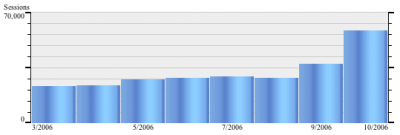Case Study: Netconcepts.com
 A pioneer in consumer-generated media and web development since 1995, Netconcepts is one of the leading voices for search engine ready e-commerce. A web design and consulting company specializing in search engine optimal web sites and applications, Netconcepts offers advice on all aspects of e-business and website development.
A pioneer in consumer-generated media and web development since 1995, Netconcepts is one of the leading voices for search engine ready e-commerce. A web design and consulting company specializing in search engine optimal web sites and applications, Netconcepts offers advice on all aspects of e-business and website development.
Problem:
Netconcepts.com is a typical corporate website, with a portfolio, testimonials, case studies, an article library, bios of the company’s executives, services, etc. As an industry innovator, it is important that we at Netconcepts practice what we preach. We knew our website was performing well, but we also knew we could do better. We wanted people to be able to see Web 2.0 principles applied to a corporate website, and to see the commensurate increase in traffic and improving search engine visibility because of it.
Solution:
In August 2006, just in time for the Search Engine Strategies conference, we rolled out a site revamp which included table-less CSS-based layout, the popular blogging platform WordPress as our new CMS (content management system), RSS feeds, and tagging (e.g. tag cloud and tag pages). Tagging, in particular, was this corporate site’s secret weapon.
First, every testimonial, every portfolio entry, every press mention, as well as each bio, article and case study, was broken out into a separate post. Then, each post was tagged with appropriate keywords. For example, all the testimonials are tagged with the word “Testimonials”. So instead of having a single testimonials page as we used to, we have a testimonials tag page that spans three web pages (at 10 posts per page) and each of the 30 testimonials is a separate web page now too. In other words, we went from 1 page to 33 pages; that’s a lot more search engine fodder, all with different keyword foci!
Spiders can find and index these tag pages through the text links contained within the tag cloud on the home page, through text links underneath each post, and through links to “Related Tags” on each tag page. Related Tags are determined from posts that have the tag (from the tag page in question) in common. So, for example, because we have posts that are tagged with both “SEO” and “Testimonials”, “SEO” then appears as a related tag on the Testimonials tag page and “Testimonials” appears as a related tag on the SEO tag page. We display links not just to the related tag pages, but to conjunctions between related tags. So, for example, you will find on our Testimonials tag page a number of Related Tags in the right hand column, all with “AND” and “OR” links adjacent to each one.
Let’s restate that a little bit differently just to clarify… All our SEO-related items (testimonials, case studies etc.) are tagged with “SEO”. Consequently, there is a tag page that relates to “SEO” and a tag page that relates to “testimonials”. There’s even a tag page that relates to “SEO testimonials” — the intersection of those two tags. That makes for ‘boatloads’ of tag pages, considering how many different permutations there are for various combinations of tags being “ANDed” or “ORed” together.
By moving to a more modular structure (based around Posts rather than Pages) along with the large inventory of new pages, that allowed us to capitalize on the “Long Tail” of natural search in ways we couldn’t dream of with our previous incarnation of brochureware.
Above the “Related Tags” you will see a RSS button which leads to a RSS feed specific to that tag page. We use that RSS feed to pull the latest articles, testimonials, seminars etc. and feature them as related content on the right column of our Services pages. For example, our Email Marketing page lists Related Articles on email marketing, because we’ve specified that the topic of the page is “email marketing” (in other words, the tag that it relates to). We use that information to grab RSS feeds of tag pages for email marketing + articles, email marketing + testimonials, etc.
Besides tagging, we have also employed many other blog SEO tactics, a number of which I detailed in my article for MarketingProfs, 10 Tips to Help Your Blog Soar in the Search Engines. This includes use of sticky posts, adding buttons to add a post to del.icio.us and various other social bookmarking services, and linking to a “Top 10” list of sorts — namely, under “Free Stuff” on the home page, some of our best content from the past year or so.
To our knowledge, this approach for search engine optimizing a corporate site has not been done before, particularly the aspect of breaking up all the discrete bits of content (each testimonial, each portfolio item, each FAQ, etc.) into individual posts and tagging all them, and then relating that tagged content with the appropriate Services pages and highlighting those as related content.
And, last but not least, the new redesigned site, although it doesn’t look markedly different from the old site, is better designed with XHTML and web standards in mind. No more tables for layout! That was long overdue.
Results:
It is amazing what can be achieved in regards to SEO just by reaching into the Web 2.0 toolkit. A corporate brochure is about as Web 1.0 as one can get, yet even brochureware can be transformed in ways one may never have thought possible and boosting search visibility in the process. In the space of just a few months after relaunch, the site went from about 100,000 pageviews per month to 390,000 by the end of October 2006. We saw a marked increase in visitor numbers as well: from about 28,000 to about 60,000 in that same timeframe.
Note in both of the above graphs the traffic trend was quite flat throughout the summer before it ramped upward starting in mid-August after the revamp launched.
Thanks to the site’s new content structure, indexation in Google increased from 300 pages to 4,800 pages, including 2,640 tag pages. Stephan Spencer, founder and president of Netconcepts, explains:
“I equate indexed web pages with a ‘virtual sales force’ that works hard to bring in traffic from the search engines for us. By adding thousands more web pages to Google’s index, we significantly expanded our ‘virtual sales force’, and because of it, our opportunities to rank well for relevant Long Tail search terms have multiplied.”
With the revamped site now powered by WordPress, a popular blogging platform, it qualifies as a blog. As such, our corporate site now enjoys visibility in the blog search engines and directories. And, because WordPress comes with RSS feed capability built in, visibility in the feed search engines and directories came too. Netconcepts.com doesn’t offer just one RSS feed, but many — grouped by topic (e.g. SEO, email marketing) and by type of resource (e.g. articles, testimonials) — all accomplished through the use of tagging.
Stephan continues:
“Since switching over to WordPress, we were also pleased to find visitors started participating on our site through comments, trackbacks, and pingbacks. Check out our SEO Title Tag Plugin page for a great example of this in action. The conversation there is still ongoing. This, happily, encourages more backlinks to our site!”

Chapter 6:
Keyword Research
From the fundamentals of link building to the nuances of natural linking patterns, virality, and authority.
Related Posts

Thursday Three: Embrace Journaling, Tackle Tardiness, and Explore Our Energetic Echo
Here’s what I found inspirational, challenging, or just downright hilarious this week. What caught your eye? And, remember to check out this week’s great podcast episodes: Scaling a SaaS Company with Jason Morehouse “A crucial factor to business success is to find and take the personal path that works best for you.” — Jason Morehouse […]
Read More
Thursday Three: Harrison’s harmony, conquering a blank canvas, & gut health hacks
Here’s what I found inspirational, challenging, or just downright hilarious this week. What caught your eye? And, remember to check out this week’s great podcast episodes: Be a Sales Game Changer with Fred Diamond “True elite sales professionals develop a dedicated mindset, proactive client interaction, and continuous self-preparation. They understand their client’s needs and enable […]
Read More
Thursday Three: Rebirth of sleeper trains, 4,000 weeks is a long/short time, and golden age for medicine
Here’s what I found inspirational, challenging, or just downright hilarious this week. What caught your eye? And, remember to check out this week’s great podcast episodes: A Story Worth Retelling with Luke Storey “Aligned values are the cornerstone of successful partnerships, whether in business or life, as they shape our moral code, define our priorities, […]
Read More


